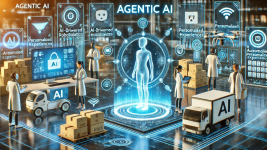The Rise of Digital-Only Banks: Progress or Premature Shift?
Tags: #ModernBanking #DigitalTransformation #NeoBanks #BankingInnovation #FinancialInclusion
In recent years, the banking sector has undergone a profound transformation with the emergence of digital-only banks, also known as neobanks. These institutions operate without any physical branches, delivering all services through digital platforms — typically mobile apps and web portals.
Their growing popularity, especially among digitally-native younger generations, has sparked an ongoing debate: Are digital-only banks the future of banking, or are we moving too quickly away from traditional, branch-based banking models?
Advantages of the Digital-Only Model
The appeal of neobanks lies in several key advantages:
Cost Efficiency: With no physical infrastructure to maintain, digital banks can offer more competitive interest rates and reduced fees.
User Experience: Fast account setup, intuitive interfaces, and personalized financial tools make digital banking highly user-friendly.
Real-Time Services: Transactions, loan approvals, and customer support can often be executed in near real-time, enhancing convenience.
Innovation-Driven Culture: Many digital-only banks adopt cutting-edge technologies such as AI for fraud detection, personalized budgeting, and automated customer support.
Risks and Limitations
Despite these benefits, several concerns continue to limit the universal adoption of digital-only banking:
Lack of Personal Interaction: Customers facing complex issues or requiring financial advice may find the absence of human, face-to-face support limiting.
Digital Exclusion: Many individuals, particularly in rural areas or among older demographics, remain underserved by fully digital systems due to limited digital literacy or internet access.
Security and Trust: While digital banks may implement strong cybersecurity measures, public trust in purely virtual financial institutions still lags behind that of traditional banks.
Crisis Management: In cases of technical failures, data breaches, or frozen accounts, customers often report frustration with limited avenues for redress compared to traditional branches.
Regulatory Considerations
As neobanks expand, regulatory frameworks must evolve accordingly. Questions surrounding data privacy, customer protection, and digital grievance redressal are becoming increasingly significant. Many regulators worldwide are working to bring neobanks under equivalent scrutiny as legacy banks — ensuring deposit insurance, capital adequacy, and transparency.
A Case for the Hybrid Model
While some digital banks operate independently, a growing number of traditional institutions are adopting hybrid approaches — combining physical infrastructure with advanced digital platforms. These models can serve as a transitional strategy, balancing modern convenience with the trust and accessibility of human support.
Hybrid banks also support financial inclusion by allowing customers to choose between digital and branch-based services according to their comfort levels and needs.
Conclusion
Digital-only banks represent a significant milestone in the evolution of financial services. However, their success should not come at the cost of accessibility, inclusivity, or consumer protection. The future of modern banking may not be exclusively digital, but rather a carefully integrated model that prioritizes both innovation and human connection.
Tags: #ModernBanking #DigitalTransformation #NeoBanks #BankingInnovation #FinancialInclusion
In recent years, the banking sector has undergone a profound transformation with the emergence of digital-only banks, also known as neobanks. These institutions operate without any physical branches, delivering all services through digital platforms — typically mobile apps and web portals.
Their growing popularity, especially among digitally-native younger generations, has sparked an ongoing debate: Are digital-only banks the future of banking, or are we moving too quickly away from traditional, branch-based banking models?
Advantages of the Digital-Only Model
The appeal of neobanks lies in several key advantages:
Cost Efficiency: With no physical infrastructure to maintain, digital banks can offer more competitive interest rates and reduced fees.
User Experience: Fast account setup, intuitive interfaces, and personalized financial tools make digital banking highly user-friendly.
Real-Time Services: Transactions, loan approvals, and customer support can often be executed in near real-time, enhancing convenience.
Innovation-Driven Culture: Many digital-only banks adopt cutting-edge technologies such as AI for fraud detection, personalized budgeting, and automated customer support.
Risks and Limitations
Despite these benefits, several concerns continue to limit the universal adoption of digital-only banking:
Lack of Personal Interaction: Customers facing complex issues or requiring financial advice may find the absence of human, face-to-face support limiting.
Digital Exclusion: Many individuals, particularly in rural areas or among older demographics, remain underserved by fully digital systems due to limited digital literacy or internet access.
Security and Trust: While digital banks may implement strong cybersecurity measures, public trust in purely virtual financial institutions still lags behind that of traditional banks.
Crisis Management: In cases of technical failures, data breaches, or frozen accounts, customers often report frustration with limited avenues for redress compared to traditional branches.
Regulatory Considerations
As neobanks expand, regulatory frameworks must evolve accordingly. Questions surrounding data privacy, customer protection, and digital grievance redressal are becoming increasingly significant. Many regulators worldwide are working to bring neobanks under equivalent scrutiny as legacy banks — ensuring deposit insurance, capital adequacy, and transparency.
A Case for the Hybrid Model
While some digital banks operate independently, a growing number of traditional institutions are adopting hybrid approaches — combining physical infrastructure with advanced digital platforms. These models can serve as a transitional strategy, balancing modern convenience with the trust and accessibility of human support.
Hybrid banks also support financial inclusion by allowing customers to choose between digital and branch-based services according to their comfort levels and needs.
Conclusion
Digital-only banks represent a significant milestone in the evolution of financial services. However, their success should not come at the cost of accessibility, inclusivity, or consumer protection. The future of modern banking may not be exclusively digital, but rather a carefully integrated model that prioritizes both innovation and human connection.

